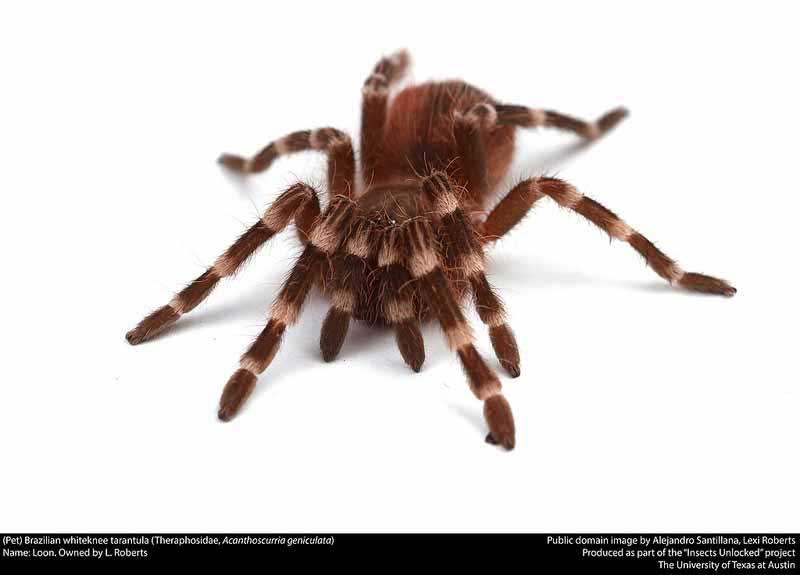
Superregnum: Eukaryota
Cladus: Unikonta
Cladus: Opisthokonta
Cladus: Holozoa
Regnum: Animalia
Subregnum: Eumetazoa
Cladus: Bilateria
Cladus: Nephrozoa
Cladus: Protostomia
Cladus: Ecdysozoa
Cladus: Panarthropoda
Phylum: Arthropoda
Subphylum: Chelicerata
Classis: Arachnida
Ordo: Araneae
Subordo: Opisthothelae
Infraordo: Mygalomorphae
Superfamilia: Theraphosoidea
Familia: Theraphosidae
Subfamilia: Theraphosinae
Genus: Acanthoscurria
Species: Acanthoscurria geniculata
Name
Acanthoscurria geniculata (Koch, 1841)
Type locality: Brazil, Roraima, Rio Branco.
Holotype: ZMB. male ♂. leg. J. Natterer. ZMB 2055
Synonyms
Mygale geniculata Koch, 1841 (original combination)
Scurria geniculata (Koch): C.L. Koch, 1850: 74
Acanthoscurria geniculata (Koch): Ausserer, 1871: 206
Acanthoscurria transamazonica Piza, 1972 (synonymized by Paula et al., 2014: 64)
Type locality: Brazil, Pará: Marabá (5°22’41.37"S, 49°6’33.69"W).
Holotype: IBSP. male ♂. I.1972. legit G. Ranzani & M. Camponez do Brasil. IBSP 138248
References
Additional references
Paula, F. dos S., Gabriel, R., Indicatti, R.P., Brescovit, A.D. & Lucas, S.M. 2014. On the Brazilian Amazonian species of Acanthoscurria (Araneae: Theraphosidae) Zoologia (Curitiba) 31(1): 63-80. DOI: 10.1590/S1984-46702014000100008 Open access. Reference page.
Links
Platnick, N. I. 2008. The World Spider Catalog, version 9.0. American Museum of Natural History. [1]
Vernacular names
English: Brazilian Whiteknee Tarantula
español: Tarántula de Rodillas Blancas
polski: Ptasznik Białokolanowy
The Brazilian whiteknee tarantula (Acanthoscurria geniculata) is a species of tarantula from Brazil that is commonly kept as a pet.
Distribution and habitat
A. geniculata is native to the Amazon basin of northern Brazil. These tarantulas live in a tropical, wet climate, characterized by abundant rainfall with little to no dry season.[2][better source needed]
Description
The body and legs of the Brazilian whiteknee tarantula are a deep black color, though occasionally the legs may be slightly lighter in coloration. This contrasts the bright white bands on its legs, which are generally considered to be the main reason for its subjective beauty. The males are smaller and less intensely colored. This is a larger species of tarantula than the norm, with the length of the body reaching up to 9 centimetres (3.5 in). These tarantulas are fast growing, usually taking around 3–4 years to reach a mature leg-span of 8.5 inches for females.[2][3][4]
As pets
These tarantulas have been much prized as pets, due to their size, hardiness, and striking coloration. They are usually somewhat defensive, and their urticating hairs can be quite irritating to human skin, as with most other tarantulas found in the Americas.[4]
These spiders, like many undomesticated pets, can bite when provoked. However, as they have urticating hairs, biting is typically not their first line of defense. Their venom is not considered medically significant, but due to their large size, they can cause mechanical damage.[4]
References
"Taxon details Acanthoscurria geniculata (C. L. Koch, 1841)", World Spider Catalog, Natural History Museum Bern, retrieved 2016-03-24
Basic Tarantula
"Tarantulas all-infos". Archived from the original on 2016-04-06. Retrieved 2016-03-23.
Tarantulas of the world
Retrieved from "http://en.wikipedia.org/"
All text is available under the terms of the GNU Free Documentation License

